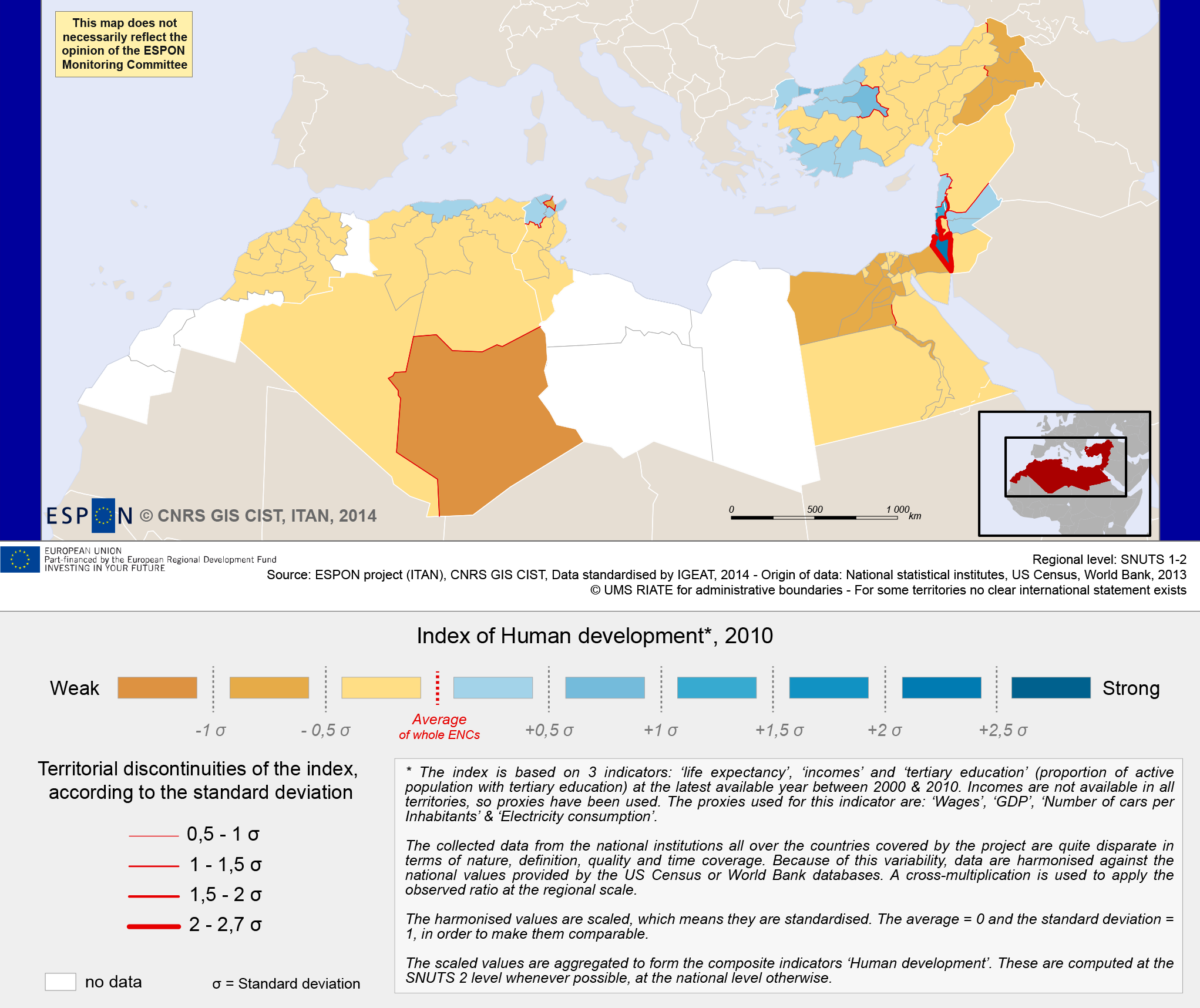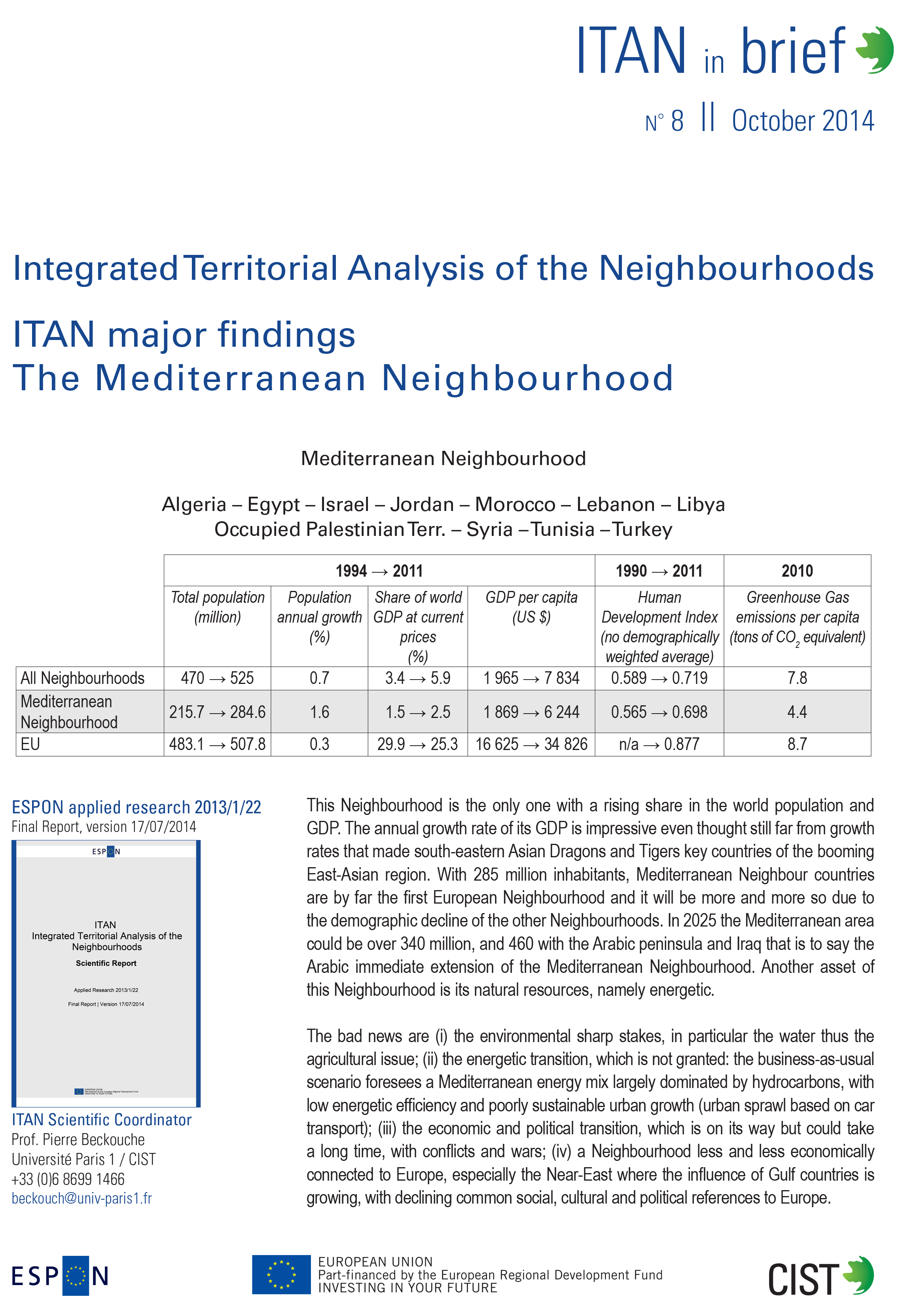
This Neighbourhood is the only one with a rising share in the world population and GDP. The annual growth rate of its GDP is impressive even thought still far from growth rates that made south-eastern Asian Dragons and Tigers key countries of the booming East-Asian region. With 285 million inhabitants, Mediterranean Neighbour countries are by far the first European Neighbourhood and it will be more and more so due to the demographic decline of the other Neighbourhoods. In 2025 the Mediterranean area could be over 340 million, and 460 with the Arabic peninsula and Iraq that is to say the Arabic immediate extension of the Mediterranean Neighbourhood. Another asset of this Neighbourhood is its natural resources, namely energetic.
The bad news are (i) the environmental sharp stakes, in particular the water thus the agricultural issue; (ii) the energetic transition, which is not granted: the business-as-usual scenario foresees a Mediterranean energy mix largely dominated by hydrocarbons, with low energetic efficiency and poorly sustainable urban growth (urban sprawl based on car transport); (iii) the economic and political transition, which is on its way but could take a long time, with conflicts and wars; (iv) a Neighbourhood less and less economically connected to Europe, especially the Near-East where the influence of Gulf countries is growing, with declining common social, cultural and political references to Europe.


For climatic reasons, the organisation of space is marked by the concentration of the settlements on a narrow littoral margin of the territory, including both an important rural density –at least in the territories which fit for agriculture– and a rapid urban growth. This Neighbourhood is experiencing, at the same time, major challenges in its rural areas (rising pressure on agricultural land, impact of rainfall shortage, risks of a straight food trade liberalisation with Europe, high rural density), and major challenges in its urban areas. Today Mediterranean partner countries cities account for 190 million inhabitants and four more million every year. The population urban rate was 64% in 2004; it will be over 75% in 2025.
The contrast in demographic growth is impressive between south-eastern Europe and western Turkey but the contrast between the latter and central Anatolia is still sharper. This can be said of the whole Mediterranean Neighbourhood: discontinuities are not that much with Europe (for instance the growth is quite alike between Morocco and south-western Spain) than within each Mediterranean Neighbour. In terms of living conditions, infrastructures, public services and social development, southern Morocco, Algeria and Egypt are much more worrisome than demographic differences along the border between Europe and its Mediterranean neighbours.
Transport networks are incomplete. Despite progress, for example on the Maghreb coastal motorway (without connection yet between Morocco and Algeria) and Moroccan on-going High Speed Railway projects, huge infrastructures remain to be made in particular for rail. Map 2 displays impressive contrasts –spectacular in Egypt– between urbanised space and arid lands.
The only exception of this pattern is Turkey, where inner Anatolia is occupied throughout an overall network of cities and transport that somehow meshes the territory, within the country and with EU neighbours thanks to the territorial continuity permitted by Istanbul bridges; this makes a major difference with other countries of the Mediterranean Neighbourhood.
Various political discrepancies entangle the transnational links between Morocco and Algeria, between Egypt, Israel and the occupied Palestinian territory, and, now on, between Syria and its neighbours.
Map 3 on local Human development depicts the Israeli specificity in this Neighbourhood, as well as that of western Turkey. However, some regions of the Arab countries benefit from a good local index: Algiers and the central urbanised coast of Algeria; the North-East of Tunisia (area of direct influence of Tunis urban region) with a strong discontinuity vis-à-vis the rest of the country including the coastal part near Sousse and Sfax; Lebanon –but here we only have a national value; and more surprisingly north-western Jordan (yet with a low demographic density). The lowest values are in south-eastern Algeria, with a life expectancy particularly low in the Mediterranean context. Several parts of Egypt show worrisome too, including governorates densely occupied such as in the Cairo area, which suggests also potential unrest. The most socially unequal national territory is Turkey.

Mediterranean Neighbour countries display the highest rates in the world for gender gap in activity (a very low percentage of women are officially active) and in employment. This gender issue is of high significance for two reasons: (i) the tangible situation of women proves difficult, with terribly low figures of women social status namely in the rural areas. The access of girls to education has dramatically improved in all the Mediterranean area, but it will take long before their access to the labour market is equal to that of men. (ii) The status of women vis-à-vis men has a lot to do with the cultural closeness vis-à-vis Europe where equality between individuals, whatever their gender, is the very basement of society. Many structural indicators show the long run convergence between the two sides of the Mediterranean, but the gap remains high in some areas namely that of gender issue.
Territories are hardly at the top of these countries political agenda, because they are rarely seen as an asset for development. When the relation between territories and economy is taken into account, it is all too often according to the rent economy that characterises Mediterranean Neighbours –were it tourism, real estates, hydrocarbons revenues, remittance or international aid, due to the lack of a modern productive system except in Turkey. When the first Tunisian revolutionary government took office in January 2011, they were stricken by the importance of the territorial divide that had been highlighted by the social unrest. The Tunisian themselves had not taken into account the dimension of the territorial inequality; hence, it has become a critical issue of the on-going political transition.

European aid received by Mediterranean Neighbours is too scattered to really impact territories, and it is decreasing. The Euro-Mediterranean really missing link is productive integration; economic future of Mediterranean partners relies on their production modernisation. In the meantime, economic regional integration between the two sides of the Mediterranean is decreasing.
Nevertheless, the Euromed Neighbourhood policy has already had four positive outcomes. One: governments practice of interacting with one another. Second: openness to international commerce in the form of trade and FDI, thanks to Agreements with EU. Third: macroeconomic stabilisation. Fourth and not least: steps taken towards deep integration in several concerted regulations: (i) financial markets, where regulators have established a Euro-Mediterranean network; (ii) environment, where initiatives date as far as 1975 when the UNEP Mediterranean Action Plan was launched; (iii) energy: since the Barcelona process, ministers opted in 2003 to move towards integrated gas and electricity markets between Mediterranean Neighbours and Europe, and since Union for the Mediterranean (UfM) decision in 2008 to launch the Mediterranean Solar Plan; (iv) transport, thanks to the EuroMed Transport Forum master plan for infrastructures.
Policy orientations for territorial issues and cooperation
Avoiding water wars
Notwithstanding the impact of global warming, the Mediterranean is already experiencing problems in access to water and sanitation that at times could lead to water conflicts. Yet water could become the cornerstone of a high-level economic channel and an ambitious international cooperation program. The priorities are well known: efficient use of water, and a water demand driven management; improved local and national governance in order to get clear contracts of water supply; pricing, that is economically appropriate, territorially efficient and socially fair; legal and financial security of investments to facilitate public-private partnerships, especially for sanitation.
A food security, rural and agricultural Mediterranean policy
The food issue will become a crucial problem owing to (i) the growing population; (ii) rising nutritional imbalances linked to the gradual abort of the Mediterranean diet made of fruits, vegetables, olive oil and fish; (iii) deteriorating ecosystems, reduction of available farming land and water resources, with serious effects on the potential of local production which currently provides more than 25 million jobs. Avenues for European cooperation deal with encouraging more local food production through significant investment in R&D and training and by setting up inter-professional channels; with promoting the Mediterranean diet and developing geographic labels so as to conquering world markets; with creating a Euro-Mediterranean regional food security. Such a policy would have a much greater impact on local territories than the actual European view limited to food export to Mediterranean Neighbours.
A “Euro-Mediterranean Energy Community”
Energy has much to do with territories: local access to electricity, solar electricity for remote areas, energy saving by compact sustainable urbanism, cross-border cooperation thanks to shared energy transport facilities. Given the resources in the Mediterranean (hydrocarbons and solar), energy is a field of obvious complementarities with Europe: (i) making both supplies and commercial markets secure in the region; (ii) enhancing the immense industrial and technological potential for the whole region (more than US$200 billion are to be invested in energy in the Mediterranean Neighbours in the coming decades) and sharing the value chain; (iii) promoting together the energy transition.
Such policy orientations suppose a real professional mobility in the region, instead of the counterproductive and humiliating hard visa regimes that prevail in the Euro-Mediterranean area.

